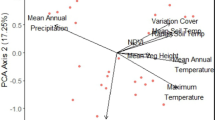Abstract
We examine costs and benefits associated with spatial position relative to spider age (size) in colonial web-building spiders. Predator attack and capture rates vary with position in the colony, and suggest that risk is higher for the smallest and the largest spiders on the periphery, and lower in the central core of the colony. Foraging success is greater on the periphery for small and medium spiders but does not differ significantly with position for larger spiders. Decreased predation risk may be the reason why larger spiders aggressively seek and defend positions in the colony core, demonstrating a “selfish herd effect” (Rayor and Uetz, 1990). Smaller (immature) spiders, unable to compete for protected web positions in the core, must trade-off potentially higher risk of predation to take advantage of higher prey availability on the periphery. Increased foraging success on the periphery may allow juvenile spiders to achieve the larger size necessary to compete successfully for protected core positions as adults. Spatial variation in size-related fitness trade-offs between predation risk and foraging success may explain why colonies are dynamic entities — with individual spiders exhibiting ontogenetic shifts in web location as they grow larger and mature-accounting for the characteristic age (size) structure ofMetepeira incrassata colonies.
Similar content being viewed by others
References
Abrahams MA, Dill LM (1989) A determination of the energetic equivalence of the risk of predation. Ecology 70:999–1007
Benton MJ, Uetz GW (1986) Variation in life-history characteristics over a clinal gradient in three populations of a communal orbweaving spider. Oecologia 68:395–399
Dill LM (1987) Animal decision making and its ecological consequences: the future of aquatic ecology and behavior. Can J Zool 65:803–811
Hieber CS, Uetz GW (1990) Colony size and parasitoid load in two species of colonialMetepeira spiders from Mexico (Araneae: Araneidae). Oecologia 82:145–150
Lima S, Dill LM (1990) Behavioral decisions made under the risk of predation: a review and prospectus. Can J Zool 68:619–640
Magurran AE (1990) The adaptive significance of schooling as an anti-predator defense in fish. Ann Zool Fenn 27:51–66
Morgan MJ, Godin J-GJ (1985) Anti predator benefits of schooling behaviour in a cyprinodatid fish, the barred killifish (Fundulus diaphanus). Z Tierpsychol 70:247–264
Pitcher TJ (1986) The functions of shoaling behaviour. In Pitcher TJ, Ed., The behaviour of teleost fishes. Croom Helm, Beckenliam, England
Rayor LS, Uetz GW (1990) Trade-offs in foraging success and predation risk with spatial position in colonial spiders. Behav Ecol Sociobiol 27:77–85
Rypstra AL (1979) Foraging flocks of spiders — a study of aggregate behavior inCyrtophora citricola Forskal (Araneae: Araneidae) in West Africa. Behav Ecol Sociobiol 5:291–300
Sih A (1980) Optimal behavior: can foragers balance two conflicting demands? Science 210:1041–1043
Sih A (1982) Foraging strategies and the avoidance of predation by an aquatic insect,Notonecta hoffmanni. Ecology 63:786–796
Stamps J (1983) The relationship between ontogenetic habitat shifts, competition and predator avoidance in a juvenile lizard(Anolis aeneus). Behav Ecol Sociobiol 12:19–33
Stein RA (1977) Selective predation, optimal foraging and the predator-prey interaction between fish and crayfish. Ecology 58:1237–1253
Stein RA, Magnuson JJ (1976) Behavioral response to a crayfish predator. Ecology 57:751–761
Treherne JE, Foster WA (1987) Group size and anti-predator strategies in a marine insect. Anim Behav 32:536–542
Uetz GW (1986) Web-building and prey capture in communal orb weavers. In: Shear WA (ed) Spiders webs, behavior, and evolution. Stanford University Press, Stanford, pp 207–231
uetz GW, Cangialosi KR (1986) Genetic differences in social behavior and spacing in populations ofMetepeira spinipes Pickard-Cambridge (Araneidae), a communal-territorial orb weaver. J Arachnol 14:159–174
Uetz GW, Hodge MA (1990) Influence of habitat and prey availability on spatial organizaton and behavior of colonial webbuilding spiders. Nat Geogr Res 6:22–40
Werner EE (1986) Amphibian metamorphosis: growth rate, predation risk, and the optimal size at transformation. Am Nat 128:319–341
Werner EE, Gilliam JF (1984) The ontogenetic niche and species interactions in size-structured populations. Annu Rev Ecol Syst 15:393–425
Werner EE, Hall DJ (1988) Ontogenetic habitat shifts in bluegill: the foraging rate-predation risk trade-off. Ecology 69:1352–1366
Werner EE, Gilliam JF, Hall DJ, Mittelbach GG (1983) An experimental test of the effects of predation risk on habitat use in fish. Ecology 64:1540–1548
Wrona FJ, Dixon RW (1991) Group size and predation risk: a field analysis of encounter and dilution effects. Am Nat 137:186–201
Zar JH (1984) Biostatistical analysis. Prentice-Hall, Englewood Cliffs NJ
Author information
Authors and Affiliations
Rights and permissions
About this article
Cite this article
Rayor, L.S., Uetz, G.W. Ontogenetic shifts within the selfish herd: predation risk and foraging trade-offs change with age in colonial web-building spiders. Oecologia 95, 1–8 (1993). https://doi.org/10.1007/BF00649499
Received:
Accepted:
Issue Date:
DOI: https://doi.org/10.1007/BF00649499




